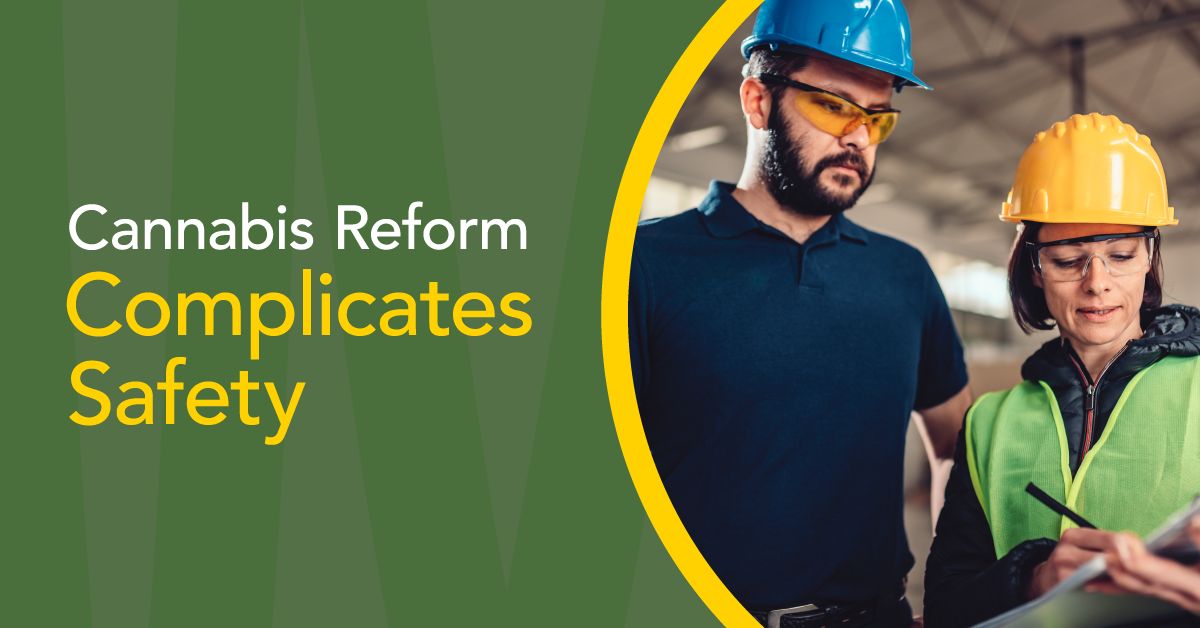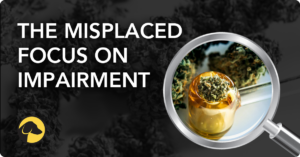
Cannabis Reform – Thoughts from Safety Professionals
THE ROLE OF A SAFETY PROFESSIONAL
Most people don’t really understand what a safety manager does. Many think we are the “safety cops” – looking to catch our colleagues doing something wrong. It may feel like that to some employees, but if I did my job well, my colleagues understood that I was trying to keep them safe – to show them how to do things to avoid injury.
INCIDENTS vs. ACCIDENTS
A safety professional works to prevent workplace incidents. I use the term “incident” instead of “accident” because the word accident fuels the notion the situation could have been prevented – when in most cases that’s not possible. Safety managers also work to promote the wellbeing of their fellow employees. They ensure employees follow health and safety regulations and create policies and training to build a safer work environment. This can be a daunting task at times because even with effective policies, training, and systems in place, incidents in the workplace still happen. Why? Well, because employees are humans, and humans can make errors and be unpredictable.
“WHY’D YOU HAVE TO GO AND MAKE THINGS SO COMPLICATED?”
It’s now 2022. Imagine you are a safety manager in a state without legal access to medical or recreational cannabis, and you have everything “under control” – policies are in place and employees are trained. You have created a well-oiled machine that limits occasions for human error. The next morning when you wake, cannabis is now legal.
The lyrics from Avril Lavigne’s song, “Complicated”, resonate and play on a loop in my head when I think about this very topic: “Why’d you have to go and make things so complicated?”
Pre-legalization, safety professionals could test pre-employment and weed out candidates who might be more of a risk than others. This was just one additional layer of protection and a very useful one for many years. But now with legal cannabis in many states, employers are tempted to remove cannabis from their pre-employment drug screening, and a few are even wondering if it would be easier to completely remove cannabis from all their drug testing panels.
SAFTEY PROFESSIONALS’ THOUGHTS ON LEGAL CANNABIS
To get a real-life perspective on the impact of legalization on the day-to-day lives of a safety professional, I asked a few industry colleagues to contribute their thoughts and experiences.
Bethany L., Safety Director, IL
“As a safety professional for a commercial general contractor, the legalization of recreational cannabis makes managing our safety risks much more challenging in several ways. Due to the high-risk nature of our work, we have many employees in safety-sensitive positions; and so, ensuring they’re unimpaired is mission-critical. We need employees to be clear-headed and able to respond appropriately to risks in the workplace at all times. More employees may engage in using cannabis now that it’s legalized, which increases the likelihood that someone may show up to work impaired. We can’t just rely on testing alone to determine impairment, as we do with alcohol, because the tests we use only tell a part of the story – if someone used cannabis, not when. We also must train employees to recognize signs of impairment, rely more heavily on those observations, and the willingness of employees to report them. It can make identifying impaired employees more difficult and it creates a different set of problems.”
Bethany raises a good point. Safety managers strive to be fair and objective. They want objective policies and training to protect all employees. To do this, I relied heavily on objective data about risks and mitigation strategies, as well as feedback from employees those policies would impact. However, if states and businesses must now rely on training employees to recognize impairment, objectivity will be lost. That’s because another characteristic of humans is unavoidable bias. The only way to ensure objectivity is to use data provided by instrument-read tests that indicate the presence or absence of recently used cannabis.
Rick L. CSP, Safety, and HR Director, UT
“As a safety manager I am wary as cannabis use legalizes in more states. My company is measuring the effectiveness of our substance abuse policy and its potency to protect workplace safety. Recently, a superintendent questioned the ethics of terminating an employee who tested positive for THC when that employee didn’t break a law (smoked marijuana legally) and was not impaired. It’s time we tune our substance policy to test for cannabis impairment. Especially as cannabis use is becoming more prevalent.”
In my recent role as a VP of Risk Control for Captive Resources, Inc. (CRI), I spoke with many companies in a similar situation as Rick – trying to maintain safety while also recognizing the new realities of employees choosing to legally use. It’s a situation that countless businesses are currently navigating with varying degrees of success. Until they can test breath for recent cannabis use (which aligns with the workday), safety managers will have a hard time determining how to use the results from conventional cannabis tests that provide positive results for cannabis use days, weeks, or months prior to the test.
Amy R, Safety and Hiring Coordinator, OK
“We had to change our policy so only safety-sensitive positions include THC in their pre-employment screening panel. With Oklahoma having dispensaries everywhere you turn, it seems like everyone has a medical marijuana card and access to cannabis. It’s just a new norm, and unfortunately, we could not get the number of hires we were needing in our non-safety- sensitive roles, so our best option was to just remove THC from their pre-employment screening. We inform all associates that THC will be included in other drugs screenings to which they will be subjected – such as a post-incident drug test. We continue to lose good candidates weekly for failing safety-sensitive drug screenings because of THC.”
As Amy and I discussed her situation, we recognized that cannabis legalization is forcing the hand of some companies who are struggling to hire in a tight labor market. Some are focusing pre-employment testing only on safety-sensitive positions which again runs counter to a safety managers’ desire for fairness and objectivity. It’s a short-term fix that Amy’s company addresses by testing both safety-sensitive and non-safety sensitive positions post-hire.
CONTINUING THE CONVERSATIONS IN 2022
Unsurprisingly, cannabis legalization has complicated how safety professionals across the country balance the need for safety with the goal of fairness. However, I am hopeful these difficult discussions will lead to improved outcomes as companies realize that by using new breath technology, they can maintain safety, ensure objectivity, and continue fair workplace practices of testing both safety-sensitive and non-safety-sensitive employees.

January 6, 2022
By JAIME FEINBERG
Share












